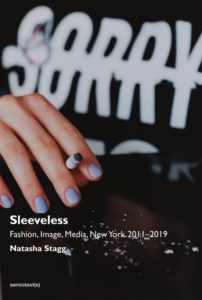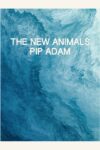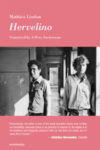 [Semiotext(e); 2019]
[Semiotext(e); 2019]
After Trump was elected president in 2016, there was a desperate mass attempt to find a silver lining to the political turmoil of his win — and one option was to believe that the resulting political turbulence would lead to an artistic renaissance (Jerry Saltz called this moment in time a “crucible of possibility”). Whether an age-defining artistic renaissance has actually happened or not is up to debate. Regardless, it’s clear that at least some art has been made that takes a critical response to the current political landscape. Even as I write this, as if to solely prove my point, frieze has published a piece called, “In Times of Crisis, Is Art a Salve or a Distraction?” And yet, not much has been said of the fashion world’s response — or whatever responses that have been made have either flown under the radar, or remained trapped within the insular sphere of its very world.
Natasha Stagg’s Sleeveless works best as a vehicle that explores the fashion world, and New York media more broadly, pre- and post-2016. Through Stagg, we are given exclusive access to an “exclusive” world that, it turns out, is not unlike ours. But Natasha Stagg’s text has other concerns, beyond humanizing the un-humanizable. In the introduction, Stagg writes:
I participate in a structure that inhibits my own creative writing while informing it. Every day, I must think about advertising strategies based on a quickly changing consumer landscape. I must gauge my own ideas of individuality, persona, and authenticity, while I internally negotiate the monetization of my generation, my identity, my space, myself. I critique fashion and I also work for fashion brands. I write about the processes of promotion and I also write ad copy. I’m skeptical of the influencer epidemic and the popularity of my writing puts me at risk of becoming influential. At times, consumerism’s close breath feels like fresh air.
As you can see, Stagg’s writing inhabits a space of contradictions. But the resulting work is incisive — only someone lucky enough to live in the center of a Venn diagram consisting of such multitudes could connect, say, Russian collusion in the 2016 election to the popularity of communist-red boots on the runway the next season. And Sleeveless is chock full of these sharp associations.
Stagg’s collection is a mix of art and fashion writing, a few celebrity profiles, and narrative fiction and nonfiction. Though Sleeveless is broken up into sections (Public Relations, Fashion, Celebrity, and Engagement), the pieces in each section could just as easily be placed in any of the other sections. I suppose that’s the point — they’re all interchangeable because, well, everything is connected. What I meant to say is that we are at a moment in which every aspect of both society and our identity informs the other. And for Stagg’s purposes, nothing is protected, and absolutely everything is up for grabs.
The release of this collection is timely, then, as if this book was made specifically for 2019, a time where beyond self-image nothing matters — yet everything is dialed up, put on full-volume, to be broadcast to the masses regardless.
I was most looking forward to re-reading what are Stagg’s sturdiest and most cogent pieces, “Two Stops” and “Bellwether Boots,” both of which had been published previously.
In “Two Stops,” arguably the strongest piece in Sleeveless, Stagg — through diary-esque entries that span the month of November 2017 — chronicles the reactions of those around her to the onslaught of sexual misconduct allegations coming to surface in New York media. It’s not that her environment reacts surprisingly, it’s that we don’t often see such ambivalent reactions extend beyond word of mouth, beyond quick whispers in dark corners of bars. It’s almost as if we are reading contraband, something that wasn’t supposed to make it to print but by some accident has — let alone twice (the essay was originally published in n+1). But Stagg isn’t throwing her contemporaries under the bus. Rather, Stagg is just unafraid of articulating her own misgivings towards the event that is #MeToo, too:
I wasn’t immune to finding power sexy. I’d gone out with men because I was impressed by their jobs, thought about leaving men and then remembered their jobs. I told myself that this wasn’t a shallow train of thought, it was actually a tribute to a man’s character: the position he held said something about him, something I was supposed to like. But now it was clear that the jobs, especially the impressive ones, were the parts I hated most about the men.
It is refreshing to read complex observations of overwhelming doubt and confusion, rather than have to fake feeling heard by the sometimes-inflexible and sometimes-staunch opinions over-published everywhere else. What I mean to say is, nothing here is one-dimensional, and so it is deserving of more than just a quick musing, forgetful and unremarkable hot take, or superficial rumination.
Over the course of the essay, Stagg writes about her feelings surrounding Louis CK’s ousting (“I wasn’t ready to live in a world that censored a pervert honest enough to say he was perverted”), dates in which men bring up #MeToo ( “It was as if they were making sure I wasn’t one of the ones who would get hysterical”), and then writes about meeting someone who identifies as hairless (“I identify as hairless”), all the while quietly jamming the knife of absurdity into contemporary New York’s spine.
Despite the tough subject and prickly opinions, Stagg provides room for the preposterous, for small pockets of chuckles, if not outright laughter. The humor in the essays lies in Stagg’s deadpan delivery and clear cynicism, and also in these moments of surprising absurdity. It is all incredibly relatable, too. But underneath the absurdity is a sense of alarm, and panic. As if Stagg can’t quite believe the goings on of the more and more dystopian world around her. She is unafraid of articulating these anxieties — but the underlying panic never quite vanishes, and instead haunts one piece to the next.
“Two Stops” ultimately exists so that Stagg can grace us with a behemoth of a reflection — and some of the best cultural commentary to come out of #MeToo:
I didn’t feel empowered; I only felt more hopeless. I wanted to watch the patriarchy go up in flames, but I wasn’t excited about what was being pitched to replace it. If we got all of it out in the open, what would we have left? My fear was that guilt would destroy the classics and there’d be no one left to fuck. All movies would be as low-budget and puritanical as the stuff they play on Lifetime, all of New York would look like a Target ad, every book or article would be cathartic tell-all, and I’d be sexually frustrated but too ashamed to hook up with assholes, or even watch porn.
But Stagg isn’t being provocative, at least not intentionally. Stagg is only a provocateur in the way someone like Susan Sontag was when she was alive and publishing, because simply having a sharp take that flutters some politically correct feathers is not provocative (Sontag, for example, was quick to point out that 9/11 was not simply a senseless attack on civilization, but an attack on a self-proclaimed superpower that was a direct consequence of said superpower’s own actions. Naturally, this is not what people wanted to hear at that moment. And yet, her writing on 9/11 is now considered some of her most brilliant.) Regardless, it’s clear Stagg is honest. And it’s writing like hers that we need nowadays, not something that beats around the bush, but something that takes a good hard look at the ugliness of the twenty-tens.
This past summer, Stagg published what could be considered a kind of companion piece to “Two Stops” titled “Welcome to the Dollhouse.” Though not included in Sleeveless, Stagg expands on her #MeToo commentary and writes, “I do not know what it is like to have my personal life shamed by my peers and colleagues. I guess I wouldn’t wish it on anyone, if I really thought about it.” Stagg is nothing if not devoted to being incessantly observant, and this newer piece is proof that she is also here to stay. “I would like for the trauma-bonded coalition formed since the #MeToo movement to stop their incessant whining. They can at least stop talking to me about it,” she writes. I mention this additional essay — a kind of fine waltz with cancel culture on the sticky ballroom floor of #MeToo — because it demonstrates that there is still much room left for thinking about #MeToo and, more broadly, the limits of power and the instability of perception. If not obvious already, Stagg’s commentary will be one to look out for as the movement progresses.
Stagg, knives sharpened, now gifts herself with the opportunity and focus to explore the fashion world’s overall response, or lack thereof, to Trump’s win. In “Bellwether Boots,” Stagg connects Russian collusion to communist fashion on the runway after Trump’s election (“At Balenciaga’s Fall/Winter 2017 runway show in Paris, one model wore a loose, floral-patterned silk dress with unadorned red knee-high boots as richly saturated as the Soviet flag”).
More specifically, Stagg writes about the styles that thrived in Eastern Europe after the fall of the Soviet Union, and how they are presently a signature for Vetements and Balenciaga designer Demna Gvasalia. The specific style is a combination of “old world values accessorized with eighties Western sex appeal.” For example, babushka-like bonnets or cheap-looking garments paired with red thigh-high boots. “In nineties Russia, East met slightly dated West,” Stagg later concludes.
But a nod to communism doesn’t make fashion political, it makes it nothing more than collage. “There was likely never a fashion month so scolded for ignoring the political present than February 2017, the month that directly followed the inauguration of Donald Trump and preceded the UK’s Brexit vote,” Stagg writes as she explores how fashion was pushed to combat it’s own political ambivalence. Instead, however, Stagg notes that it is the same people who can afford luxury shopping that benefit from Trump’s presidency. Ultimately, fashion brands fail at being political and, instead, succeed in being impotent. Which is to say, fashion both is a distraction against the world falling apart, and also a call of attention for the need of a space of liberation. But despite this, we know that absolutely nothing will change, and the world of fashion will continue to spin uninterrupted.
There are a few weak(er) pieces in Sleeveless, though Stagg is a sharp critic so these moments are still worthy of your time. For a collection, however, I wish Sleeveless would have been a slightly slimmer volume with only Stagg’s strongest pieces. But maybe I am biased (I am not a fan of “Confidence,” but perhaps that’s because I am neither a fan of the artist profiled, nor a fan of the additional artists interviewed, for example). Having said that, in addition to “Two Stops” and “Bellwether Boots,” I was surprised to find myself slip into other pieces that I would not on first glance think much of.
“Good-looking People” hones in on the social complexities at play with the brand Abercrombie & Fitch. Stagg sharply observes how A&F “advertised a name that said fitness, youth, and casual sex. A&F was not snobby country club attire or logo-less workwear, it was somewhere in between. More importantly, it was for those casually peaking in high school.” Their ads were softcore porn, and their nightclub-like stores that bumped music were guarded by fit and shirtless men. All in all, A&F, through the help of its publication A&F Quarterly — which, like its stores, was packaged like porn and made up of hard bodies with sly smiles and which were sometimes pinned down by other shirtless people of the same sex — provided its youth consumer base with a sexual awakening as well.
According to Stagg, A&F was a lifestyle brand, one initially catered to and worn by the white in-crowds in high school (“The idea was to limit wearers to the privileged middle class youth by capping the sizes offered, blatantly appearing racist, and loudly proclaiming their target”). But — and more interestingly — Stagg notes that once A&F became unpopular, the working class, non-white consumer who was initially oppressed by the brand was now the only one buying it. Better yet, Stagg now suspects that hip urban young-adults are arriving next in the cycle — first alternative New Yorkers welcomed Brandy Melville, and next on the list is Abercrombie & Fitch. What a time to be alive!
In “Right Place,” a piece in which the main subject is the Kardashian family, Stagg writes that Kim is
performance and pastiche, she is appropriation and readymade, she is a Factory Superstar. She’s not exactly the “Marilyn Monroe of our time,” as Kanye suggested, but maybe she’s more like Marie Antoinette: unexpected, obliviously reckless, and destined for demise. She’s like neither, really, but she’s also like both. She’s an easy emblem of an era. The era being, of course, late capitalism.
Stagg careens through observations like this, with incredibly astute language, in an essay that hones in on the commodification of the self. Stagg neither strikes nor shields the Kardashians in regard to this packaging of identity and immediate selling of it. Instead, she acknowledges her implicit — and perhaps to a degree involuntary — participation in this system.
But she does something else here, too, and makes Kim’s process of identity formation a more dynamic one: “Kim is every race and no race, smoothed and filled and bronzed and contoured beyond natural indicators. Was racial transcendence her idea, or was it a makeup artist’s?” Then, later, Stagg points out a contradiction: “The Kardashians don’t do their own makeup, and are wildly successful makeup moguls.” Remarkably, Stagg comes after Kim’s race, and her family’s businesses — she takes no prisoners. Yet, Stagg is also able to applaud Kim for her savviness: Kim can bake her zero-carb/zero-sugar cake and eat it, too.
Lastly, there is “Out of State,” the fragments of which are from an ongoing series published for Spike Art magazine each summer. The pieces of text here vary in topic (Stagg was commissioned to write one column a week about whatever she wanted). The strongest moments in “Out of State” are those in which Stagg writes (self-)critically about dating a garbage man. For example, during a reading Stagg gives at PS1, she observes that the garbage man was intimidated by her comfort-level around such a large amount of people. Naturally, this would intimidate me, too. But he wasn’t overwhelmed by Stagg’s intelligence or success, since he had versions of both of those things, too. Instead, proving your social fluency and social comfort is what yanks the curtain away and declares: yes, we are of different worlds, and, no, we will never overcome this.
The piece is heartbreaking and, again, Stagg is unafraid of taking a long hard look in the mirror. She’s achingly honest, even if she risks showing what may be uglier traits, but traits that she shares with the world nonetheless. “It was this game I kept playing, letting him know that he should be impressed by me and then letting him know that I considered my own success negligible, which probably made him feel like nothing,” Stagg writes.
Each piece in Sleeveless points towards the spectrum of anxieties that living in the twenty-tens is made of: social, consumerist/capitalist, urban, and, most importantly, political anxieties. But Sleeveless would not exist outside of the socio-political hellscape that the past few years have been. Though Trump is often name-checked in the essays, even in those where he isn’t explicitly named, his specter still haunts the page. Stagg’s work is political, which in itself isn’t unique. Rather, it is Stagg’s cynical and honest observations, and her distinctive and advantageous viewpoint (how many other texts do you know that confront the Trump era do it through a — mostly — fashion lens?) that make Sleeveless so unlike anything else out there.
Josh Vigil is a writer living in New York.
This post may contain affiliate links.







